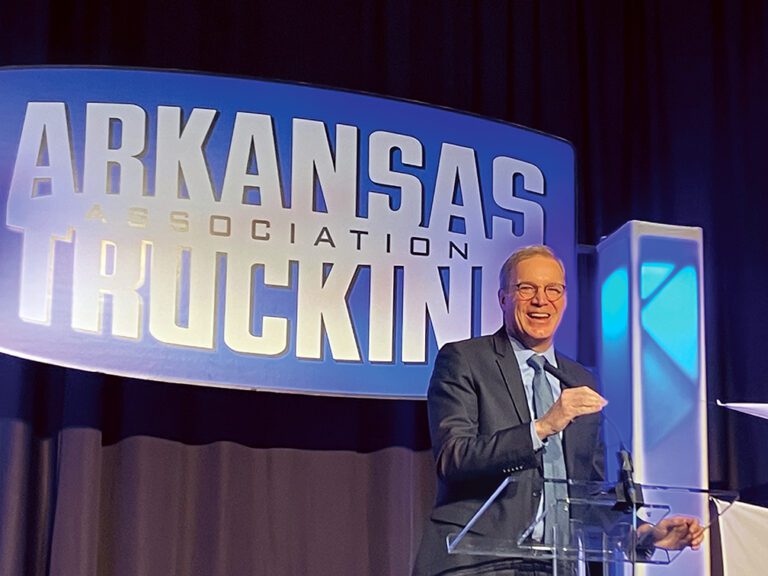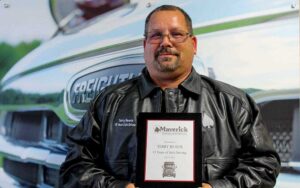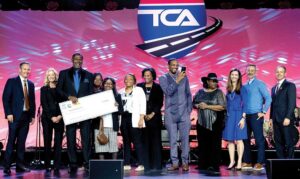LITTLE ROCK, Ark. — American Trucking Associations (ATA) President and CEO Chris Spear is sounding the alarm about new federal emissions regulations and the impact he says they will have on the trucking industry.
During the Arkansas Trucking Association’s annual conference Wednesday, May 17, in Little Rock, Spear told attendees that it’s time to “turn up the volume and let our story be heard.”
The third phase of the Environmental Protection Agency’s (EPA) Clean Trucks Plan has caused the issue of big rig emissions to boil over.
“Phase 3, on NoX, that’s the toughest stuff,” Spear said. “It’s like squeezing blood out of a rock.”
The Clean Trucks Plan calls for reducing production of diesel-fueled rigs and replacing them with vehicles powered by electricity or other alternative fuel sources in the coming years. In December 2022, the EPA finalized part of the plan that calls for cutting cut smog-and soot-forming emissions from new heavy-duty trucks beginning with model year 2027.
Spear contends the trucking industry has already made great strides in helping to reduce emissions on diesel engines.
“For 40 years, we have worked hand-in-glove with the SmartWay program with the EPA,” Spear said. “We have recognized carriers that have kept up with the latest environmentally friendly equipment.”
Spear added that the industry has “been through the process to ensure equipment on the market can withstand the pressures that drivers put them though and still deliver reductions for the environment.” The ATA, he said, is “all in favor of clean air and water. That is not debatable. But in four decades, we have worked to pull 98.5% of harmful emissions out of the tailpipes of trucks you buy on the lots today.”
It would take 60 modern Class 8 trucks, he said, to match the emissions produced by a single rig back in 1988.
“That’s a very good story,” he said. “That’s innovation. That’s the industry collaborating with the EPA to create a positive outcome.”
Phase 3 of the Clean Trucks plan includes new and stronger greenhouse gas standards effective for model years 2027 through 2032. The program revises the model year 2027 standards to be more stringent than the existing Phase 2 greenhouse gas standards for vocational vehicles and day cab tractors, moving toward the goal of zero emissions.
Phase 3 also introduces new standards for vocational vehicles and day cab tractors that become increasingly stringent every model year from 2028 through 2032. For sleeper cab tractors, the proposed Phase 3 program introduces new standards in model year 2030 that increase in stringency in model years 2031 and 2032.
Spear pointed to California’s Air Resources Board as another “thorn” in the side of the trucking industry. California, he said, “is the breeding ground for all bad policy.”
The Biden administration cleared the way on March 31 for California’s plan to phase out a wide range of diesel-powered trucks as part of the state’s efforts to drastically cut planet-warming emissions and improve air quality in heavy traffic areas, such as ports along the coast.
The EPA’s decision allows California — which has some of the nation’s worst air pollution — to require truck manufacturers to sell an increasing number of zero-emission trucks over the next couple of decades. The rule applies to a wide range of trucks, including box trucks, semis and even large passenger pick-ups.
The EPA typically sets standards for tailpipe emissions from passenger cars, trucks and other vehicles, but California has historically been granted waivers to impose its own, stricter standards. Other states can then follow suit. At least eight other states plan to adopt California’s truck standards, California Gov. Gavin Newsom’s office said. In a letter last year, attorneys general from 15 states, Washington, D.C., and New York City urged the EPA to approve the California truck standards.
The new truck standards in California are aimed at companies that manufacture trucks as well as those that own large quantities of large trucks. Companies owning 50 or more trucks will have to report information to the state about how they use these trucks to ship goods and provide shuttle services. Manufacturers will have to sell a higher percentage of zero-emission vehicles starting in 2024. Depending on the class of truck, zero-emission ones will have to make up 40% to 75% of sales by 2035.
Spear reiterated that the ATA is not “anti-environment” but rather wants to see already-in-place measures, such as cleaner diesel engines, make their way into the hands of drivers before the dramatic shift toward electric and alternative powered trucks begins.
“We don’t have the infrastructure for electric trucks,” he said. “(But) let’s say we do. Well, where is the power going to come from? An ATRI (American Trucking Research Institute) report shows that if you electrify every car and truck on the road, 40% more electric capacity is needed across the nation. Where will that come from?”
Spear also pointed to the amount of time it takes to fuel up a diesel truck verses charging an electric one.
“It takes 15 minutes to fill a tractor (with diesel) and go 1,200 miles,” Spear said. “How can you replicate that productivity in the industry today (with electric power)?”
Spear said that, in California alone, 53% of the big rigs on the roads are 2010 models and older. He said there need to be incentives in place for purchasing new, more environmentally friendly diesel models.
“You could reduce emissions by 83% right now (in California),” Spear said. “Why isn’t anyone wanting to talk about this? It’s our responsibility as an industry to get loud on these points.”
Spear also touched on other topics facing the trucking industry, including the Federal Motor Carrier Safety Administration’s (FMCSA) speed limiter proposal for commercial vehicles. A final ruling on the issue is expected later this year, he said, adding that the ATA supports the measure.
The FMCSA has not yet said what the speed cap would be.
In his remarks, Spear also launched criticism toward the Owner-Operator Independent Drivers Association (OOIDA) over its stance against the limiters.
“I have really found it interesting that OOIDA has described this (speed limiter proposal) as ‘an ATA rule,’” he said. “I did not know that I had the authority to propose federal rulemakings. Apparently, I need to go back and check the bylaws … I guess I do.”
Spear added, “OOIDA has basically come out, had a bill introduced in the House opposing this rule — a rule that no one outside the agency has seen. Nobody knows what the rule is; it’s not out yet. So, we’re drawing legislation to oppose a rule that’s not even out yet, which basically says that they’re OK driving as fast as they want … we already know they want to drive as long as they want, based on their opposition to ELDs (electronic logging devices).”
Spear went on to say he’s “not beating up on owner-operators, but I think some of their representation in OOIDA is very anti-safety. I’m just gonna simply call it like it is. You cannot be allowed to drive as long as you want as fast you can. That’s not safety.”
The Trucker asked OOIDA for a response to Spear’s remarks, and OOIDA President Todd Spencer sent the following statement via e-mail:
“In 2016, Chris Spear called FMCSA’s speed limiter rulemaking ‘dangerous.’ Now he claims those opposing it are anti-safety. And he seems to have forgotten entirely that his organization petitioned the agency to launch this rulemaking in the first place. If the mandate is defeated, he’ll probably take credit for stopping it. There’s no telling what ATA’s position is on a given day, but you can almost always count on them not supporting professional drivers and their needs. That’s the difference between OOIDA and ATA, we trust the men and women who make their living behind the wheel to know what will improve safety on our highways.”
On May 10, OOIDA’s executive vice president Lewie Pugh, in testimony before the House subcommittee on highways and transit, said speed limiters would exacerbate supply chain challenges.
“By prohibiting hundreds of thousands of trucks from traveling at the posted speed limit determined by states, this mandate will literally slow down freight movement across the country,” Pugh said. “For example, OOIDA members currently operate roughly 240,000 heavy vehicles on our nation’s roads. Based on our members’ strong reaction to the proposal, we suspect very few, if any, currently use speed limiters. Limiting just our members to a maximum speed as low as 60 mph would alone have a profound impact on the movement of goods in our economy, but the rulemaking will impact countless other CMVs.”
Further, Pugh said, if the speed limiter mandate is implemented, “more trucks will be needed to carry the same amount of freight in the same amount of time, which increases road congestion and can further slow freight movement.”
Back in Little Rock, Spear closed out his address to the Arkansas Trucking Association’s members by touching on truck parking and infrastructure, along with the Bipartisan Infrastructure Law (BIL), which has earmarked money to bolster the nation’s roads and bridges, along with other projects.
Spear pointed out that both ATA and OOIDA have worked hard to ensure that money is funneled from the BIL into truck parking.
“Now I will say something positive about OOIDA,” Spear said. “When we lock arms on an issue, it has an impact. And for Todd and I to sign a letter to the secretary of transportation asking that those monies go to truck parking, they’re paying attention.”
Born in Pine Bluff, Arkansas, and raised in East Texas, John Worthen returned to his home state to attend college in 1998 and decided to make his life in The Natural State. Worthen is a 20-year veteran of the journalism industry and has covered just about every topic there is. He has a passion for writing and telling stories. He has worked as a beat reporter and bureau chief for a statewide newspaper and as managing editor of a regional newspaper in Arkansas. Additionally, Worthen has been a prolific freelance journalist for two decades, and has been published in several travel magazines and on travel websites.








